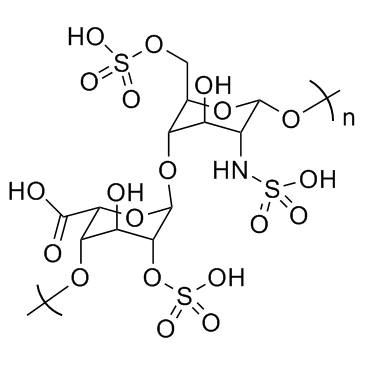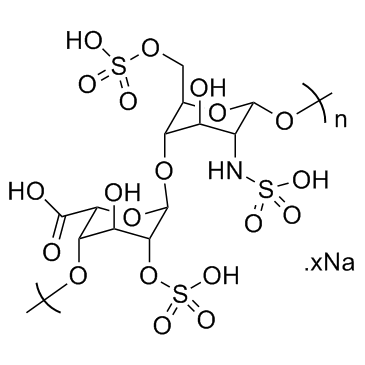CHEMICAL IDENTIFICATION
-
RTECS NUMBER :
-
MI0700000
-
CHEMICAL NAME :
-
Heparin
-
CAS REGISTRY NUMBER :
-
9005-49-6
-
LAST UPDATED :
-
199706
HEALTH HAZARD DATA
ACUTE TOXICITY DATA
-
TYPE OF TEST :
-
TDLo - Lowest published toxic dose
-
ROUTE OF EXPOSURE :
-
Subcutaneous
-
SPECIES OBSERVED :
-
Human - man
-
DOSE/DURATION :
-
1857 units/kg/13D-I
-
TOXIC EFFECTS :
-
Cardiac - other changes Nutritional and Gross Metabolic - changes in potassium
-
TYPE OF TEST :
-
TDLo - Lowest published toxic dose
-
ROUTE OF EXPOSURE :
-
Subcutaneous
-
SPECIES OBSERVED :
-
Human - woman
-
DOSE/DURATION :
-
1000 units/kg/5D-I
-
TOXIC EFFECTS :
-
Nutritional and Gross Metabolic - changes in potassium
-
TYPE OF TEST :
-
TDLo - Lowest published toxic dose
-
ROUTE OF EXPOSURE :
-
Intravenous
-
SPECIES OBSERVED :
-
Human - man
-
DOSE/DURATION :
-
3536 units/kg/13D-I
-
TOXIC EFFECTS :
-
Nutritional and Gross Metabolic - changes in potassium
-
TYPE OF TEST :
-
LD50 - Lethal dose, 50 percent kill
-
ROUTE OF EXPOSURE :
-
Oral
-
SPECIES OBSERVED :
-
Rodent - rat
-
DOSE/DURATION :
-
1950 mg/kg
-
TOXIC EFFECTS :
-
Details of toxic effects not reported other than lethal dose value
-
TYPE OF TEST :
-
LDLo - Lowest published lethal dose
-
ROUTE OF EXPOSURE :
-
Intraperitoneal
-
SPECIES OBSERVED :
-
Rodent - rat
-
DOSE/DURATION :
-
420 mg/kg
-
TOXIC EFFECTS :
-
Details of toxic effects not reported other than lethal dose value
-
TYPE OF TEST :
-
LD50 - Lethal dose, 50 percent kill
-
ROUTE OF EXPOSURE :
-
Intraperitoneal
-
SPECIES OBSERVED :
-
Rodent - mouse
-
DOSE/DURATION :
-
1900 mg/kg
-
TOXIC EFFECTS :
-
Behavioral - altered sleep time (including change in righting reflex) Behavioral - somnolence (general depressed activity) Behavioral - muscle weakness
-
TYPE OF TEST :
-
LD50 - Lethal dose, 50 percent kill
-
ROUTE OF EXPOSURE :
-
Subcutaneous
-
SPECIES OBSERVED :
-
Rodent - mouse
-
DOSE/DURATION :
-
500 mg/kg
-
TOXIC EFFECTS :
-
Behavioral - somnolence (general depressed activity) Behavioral - muscle weakness
-
TYPE OF TEST :
-
LD50 - Lethal dose, 50 percent kill
-
ROUTE OF EXPOSURE :
-
Intravenous
-
SPECIES OBSERVED :
-
Rodent - mouse
-
DOSE/DURATION :
-
500 mg/kg
-
TOXIC EFFECTS :
-
Behavioral - somnolence (general depressed activity)
-
TYPE OF TEST :
-
TDLo - Lowest published toxic dose
-
ROUTE OF EXPOSURE :
-
Intravenous
-
DOSE :
-
2857 units/kg
-
SEX/DURATION :
-
male 5 day(s) pre-mating
-
TOXIC EFFECTS :
-
Reproductive - Paternal Effects - other effects on male
MUTATION DATA
-
TYPE OF TEST :
-
Unscheduled DNA synthesis
-
TEST SYSTEM :
-
Rodent - guinea pig Bone marrow
-
DOSE/DURATION :
-
5 mg/L
-
REFERENCE :
-
FOBLAN Folia Biologica (Prague). (Academic Press Inc. Ltd., 24-28 Oval Rd., London NW1 7DX, UK) V.1- 1955- Volume(issue)/page/year: 16,196,1970 *** REVIEWS *** TOXICOLOGY REVIEW AEMBAP Advances in Experimental Medicine and Biology. (Plenum Pub. Corp., 233 Spring St., New York, NY 10013) V.1- 1967- Volume(issue)/page/year: 52,375,1975 TOXICOLOGY REVIEW JPMSAE Journal of Pharmaceutical Sciences. (American Pharmaceutical Assoc., 2215 Constitution Ave., NW, Washington, DC 20037) V.50- 1961- Volume(issue)/page/year: 62,517,1973 *** NIOSH STANDARDS DEVELOPMENT AND SURVEILLANCE DATA *** NIOSH OCCUPATIONAL EXPOSURE SURVEY DATA : NOHS - National Occupational Hazard Survey (1974) NOHS Hazard Code - 84488 No. of Facilities: 374 (estimated) No. of Industries: 3 No. of Occupations: 8 No. of Employees: 4525 (estimated) NOES - National Occupational Exposure Survey (1983) NOES Hazard Code - 84488 No. of Facilities: 430 (estimated) No. of Industries: 4 No. of Occupations: 14 No. of Employees: 27273 (estimated) No. of Female Employees: 23149 (estimated)
|


